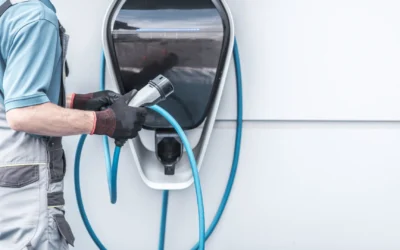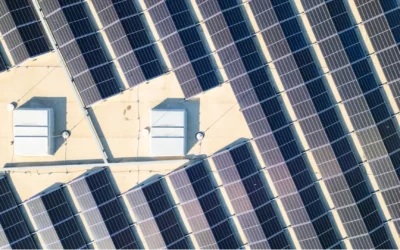Inspection and maintenance of the electric power grid can be a risky, time consuming and sometimes an inaccessible task. As mentioned in the previous article, which focused on robots, drones and transmission lines, robots can minimize human interaction with High Voltage (HV) equipment and make the process of regular maintenance easier. This article focuses on substations and the wind industry.
The U.S. Bureau of Labor Statistics data showed that the major cause of fatalities in the power grid industry was through electrocutions, but other causes were falls, fires and explosions, accidents due to confined spaces, and environmental stress. Environmental stress includes exposure to thermal stress, materials like asbestos and lead (present in older substations) and electromagnetic fields emitted from electrical equipment and power lines.
Substations
Workers deployed at substations are surrounded by HV equipment, and confined to tight spaces, so it is important they remain extra cautious working around active equipment. There were at-least 10 reported major injury incidents in the period 2009 to 2014 at substations in the UK alone. (Health and Safety Executive, UK).
Recently, Boston Dynamics deployed their robot, called Spot, at a National Grid HVDC station as a pilot project. Spot (Figure 1) is a four-legged robot that has a dog-like walk and can traverse over uneven surfaces of the substation while collecting information about the equipment. The robot was placed in the thyristor valve hall that converts the 450kV DC to 345kV AC and requires constant inspection. The robot was tested to withstand electromagnetic interference from the facility and the robot was tested to ensure it did not affect the sensitive equipment around it. Spot managed to collect high-definition images of the gauges, bushings and other equipment while also identifying hot spots that could be potential problems.
SMP Robotics, has been producing robots commercially for security and inspection since 2019. In 2020, the company introduced a robot that can be used to inspect electrical equipment. Equipped with a thermal measuring camera and a high-resolution optical camera, S3.2, will be able to inspect equipment under the control of an operator. The robot can move automatically between the equipment using its six circular video surveillance cameras and can work in close proximity to HV equipment and power lines.

Figure 1: Boston Dynamics Sport Robot.
This image is a property of Boston Dynamics

Figure 2: S3.2 robot equipped with thermal imaging camera and optical camera to inspect equipment.
This image is a property of SMP Robotics
Wind Industry
According to U.S. Energy Information Administration (EIA) China leads in wind generation, followed by the U.S., Germany, India and the UK. In the U.S., wind power has been one of the fastest growing sources of energy increasing 8.2% from 2018 to 2019. In the UK, the government just increased the offshore wind energy requirement, from 30 GW to 40 GW by 2030. All this essentially means increased maintenance requirements for wind turbines.
Turbine blades, usually made of composite materials, are subjected to lightning strikes, foreign object strikes and blade erosion. All this contributes to reducing the aerodynamic efficiency of the blades thus lowering the productivity. Worldwide, for the past year, 3,800 blades failed owing to poor maintenance. Maintenance surveys of wind turbines is usually conducted by maintenance engineers who climb wind turbines and blades.
Forth Engineering, alongside a consortium of partners, is working on a solution for enhancing the operational efficiency of wind turbines. RADBLAD , to be delivered this year, is a lightweight, magnetically adhering robot with a manipulator arm deploys an X-ray system around the blade. This robot is capable of conducting a full X-ray survey of a Vestas V47 size turbine and its blades in a few hours.

Figure 3: RADBLAD technology to carry out full X-ray survey of wind turbines.
This image is a property of Forth Engineering
In 2020, Rope Robotics, funded by the European Union, tested their robot on wind turbines in South Africa, Denmark and Canada. The BR-8 robot was not only able to perform safer and more efficient inspections but can also make leading-edge repairs as well.

Figure 4: BR-8 robot from Rope Robotics.
This image is a property of Rope Robotics
In 2019, BladeBUG was awarded funding from Innovate UK, and in 2020 the six-legged robot was tested on an operational offshore turbine. This robot scanned the wind turbine blade for cracks and imperfections communicating its findings to the shore.
Looking Ahead
The benefits of using robots in substations, not only kept human workers out of danger, but the frequency of inspection can be increased without compromising system reliability, and shutdowns can be reduced. With standardized thermal and optical imagery, the data acquired can be more consistent and can used for predictive analysis.
As renewable energy gains popularity around the world, wind energy will also grow and the benefits of reducing costs and increasing value become more important. Robots may provide the answer. With the advancements in AI, imaging and robotics, new avenues have opened for the deployment of robots in the power sector, and we may be able to turn these dangerous jobs into a much safer – robot assisted professions.
More about our Power Grid Market Research
Recent Insights
PTR Enters Media Partnership with PCIM Asia Shanghai 2025
PTR Enters Media Partnership with PCIM Asia Shanghai 2025 SUNNYVALE, USA, June 12, 2025 – Power Technology Research (PTR), a global authority in market intelligence for the energy and power sectors, today announces its Official Media Partnership with PCIM Asia...
PTR Partners as Official Media Partner for Net Zero Europe – Solar & Energy Storage Summit 2025
PTR Partners as Official Media Partner for Net Zero Europe – Solar & Energy Storage Summit 2025 SUNNYVALE, USA, June 10, 2025 – Power Technology Research (PTR), a global authority in market intelligence for the energy and power sectors, is pleased to announce its...
Key Strategies for EV and EVCI Expansion
The authors, Mike Sheppard, CEO of PTR Inc. & Zainab Shah, Lead EVCI Analyst - Americas, highlight how the U.S. EV and charging infrastructure sectors are navigating a new era shaped by policy shifts and economic pressures. Following the rollback of key federal...
Harnessing the Sun: The Middle East’s Shift to Solar Power and Storage
In this article, PTR's CPO, Saqib Saeed, and Research Analyst, Siddiqa Batool, explain how the Middle East is accelerating its transition toward renewable energy—particularly solar power—supported by a growing focus on energy storage. Countries like Saudi Arabia, the...

